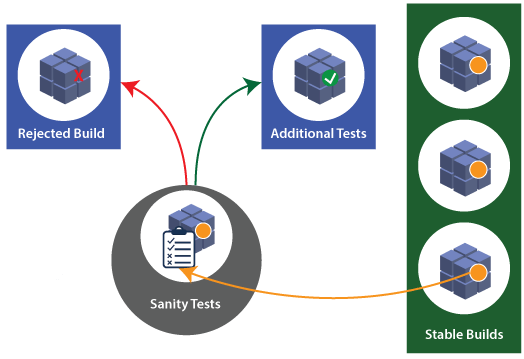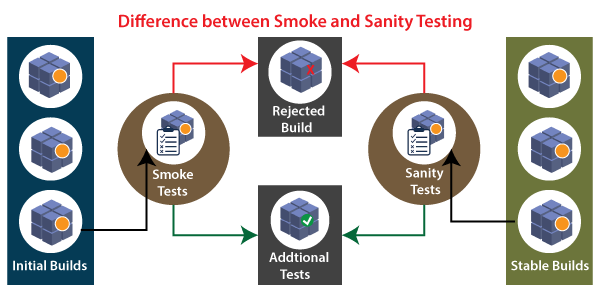In this section, we are going to discuss what is smoke and sanity testing in Software Testing; and see the major differences between them.
In software testing, we will understand that any testing done at the initial phase of the SDLC (Software Development Life Cycle) is determined to be a cost and time-saving process.
Smoke Testing and Sanity Testing are a few of the significant types of testing, making sure that bugs and defects are exposed in the development cycle's initial phases.
Usually, we all get muddle between the definition of Sanity Testing and Smoke Testing. Firstly, both testing is way different and executed throughout the different phases of a testing cycle.
Before understanding the smoke and sanity testing, it is suggested to understand Build and Release and how these terms are related to the Smoke and Sanity Testing.
What is Build?
In manual testing, build is software that contains some set of features/bugs and it is installed on a test server that needs to be tested for the product's stability.
In other words, we can say that the build is used to change the code into the application format. Every new build will be the improved version of the new build.
For more information about the software build and build process, refer to the following link: https://www.javatpoint.com/manual-testing.
What is Release?
In software testing, it is very common terminology used on an everyday basis. The Release is a final product or a project, which is delivered to the customer.
It involves the complete activities from the Requirement, Designing, Development, and Testing phases until it is handed over to the customer.
In other words, we can say that a release is an entirely developed application, while the build is the part of an application or the software.
Note: Whenever a build is tested and specialized by the testing team, it is handed over to the clients as Release.
Now, let's see a brief introduction of Smoke Testing and Sanity Testing procedures.
What is Smoke Testing?
It is a type of testing that guarantees an application's basic and critical features are working fine before doing exhaustive testing or rigorous testing.
Smoke testing is also known as a subcategory of acceptance testing or Build Verification testing.
In other words, we can say that smoke testing is used to test all the functionality of the software product or check whether the build is broken or not.
In smoke testing, we only perform positive testing, which implies that we can enter only the valid data not invalid data.
Whenever a new build comes in, we always start with smoke testing because some changes might have broken a major feature of a new build.

For in-depth information about smoke testing, refers to the following link: https://www.javatpoint.com/smoke-testing.
What is Sanity Testing?
It is performed to check whether the bugs have been fixed after the build. Generally, Sanity testing is performed on stable builds. It is also known as a variant of regression testing.
The initial aim of performing sanity testing is to determine that the planned features work roughly as expected. If the sanity test fails, the build is rejected to save the costs and time complex in more severe testing.

For more details about sanity testing, refers to the following link: https://www.javatpoint.com/sanity-testing.
Note: A Dry Run is a testing process where the consequences of a possible failure are purposefully mitigated.
Whenever we talk about smoke and sanity testing, we know that these two types of testing are similar, but both smoke testing and sanity testing have their purposes and significance.
Therefore, in this article, we try to overcome the Smoke and Sanity testing's confusion by seeing the key difference between them.
The key difference between Smoke Testing and Sanity Testing
The below facts explain the differences between smoke and sanity testing:

- Smoke Testing is scripted, which means it can be documented, whereas the sanity testing is unscripted, which implies that it cannot be documented.
- Smoke testing is considered shallow and wide testing, and on the other hand, sanity testing is considered narrow and deep testing.
- Smoke testing takes all important features and performs high-level testing, whereas sanity testing takes some very significant features and performs deep testing.
- Smoke testing is executed as soon as the build is installed, and on the other hand, sanity testing is implemented as soon as the bug fixes are done.
Smoke Testing vs Sanity Testing
The below comparison table enlightens the important differences
between smoke testing and sanity testing in a quick manner:
|
S.No. |
Comparison Basis |
Smoke Testing |
Sanity Testing |
|
1 |
Test coverage |
It is a broad
approach to testing where all parts of the application are tested. |
It is a narrow
approach to testing where specific parts of the application are tested. |
|
2 |
Measures |
It measures the
stability of the system by performing rigorous testing. |
It measures the
rationality of the system by performing rigorous testing. |
|
3 |
Technique |
Smoke testing can be
either manual or automated. |
Sanity testing can
be done without test cases or scripts. |
|
4 |
Executed by |
It is performed by
both testers and developers. |
It is performed by
only testers. |
|
5 |
Purpose |
Testing is done
without getting into deep but whenever needed tester has to go into deep. |
Sanity testing does
not need to go into deep of the application. |
|
6. |
Performed at |
Smoke testing is the
first testing performed on the initial build. |
Sanity testing is
performed when the build is comparatively stable. |
|
7 |
Documentation |
Smoke testing is
documented. |
Sanity testing is
not documented. |
|
8 |
Used to |
It is used to test
End to End function of the application. |
It is used to test
only modified or defect fixed functions. |
|
9 |
Subset |
It is considered as
a subset of acceptance testing. |
It is considered as
a subset of regression testing. |
Conclusion
These are the basic testing concepts that is followed by most of the quality assurance and projects teams in various software development projects.
The beginner in testing needs to know Smoke and Sanity testing's fundamentals for effective and good Quality Assurance outcomes.
Both smoke testing and sanity testing can either be implemented manually or with some automation tools. When automation tools are used, tests are started to create the build repeatedly.
As per the software's need, we can perform smoke or sanity testing in a similar software build. In a situation like this, we will first implement the Smoke tests and then proceed with Sanity Tests.
In the software industry, test cases for Sanity Testing are usually shared with smoke tests to accelerate the test execution process.
Both Sanity and Smoke testing are different ways to avoid delay and energy by quickly defining whether an application is too damaged to excellence any rigorous testing.



0 Comments